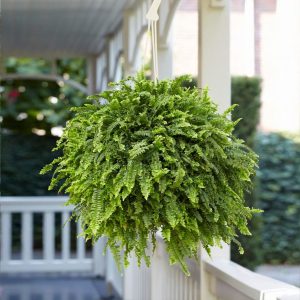Boston Fern

- Botanical Name: Nephrolepis exaltata
- Family Name: Nephrolepidaceae
- Stems: 1-3 Feet
- Temperature: 15-30°C
- Others: Scattered light, high humidity, moist soil
Overview
Product Description
Boston Fern: A Green Odyssey
From the Tropics, the “Green Mane”
Boston Fern (Nephrolepis exaltata), this “green mane” beauty from the tropical Americas, with its elegant form and graceful posture, has crossed mountains and rivers from the tropical rainforests of southern Mexico to Brazil, arriving in the homes of gardening enthusiasts around the world.

Boston Fern
The “Green Garment” Gentleman
Boston Fern, this “green garment” gentleman, has its own unique preferences for the environment. It likes to stretch leisurely under diffused light, avoiding direct sunlight to prevent burning its delicate leaves. It prefers warm and humid environments, with the most suitable growth temperature between 18-24°C, and is not fond of cold weather.
It requires at least 60% humidity to keep its leaves fresh and healthy, so in dry environments, humidity can be increased by spraying or placing a water tray. It is suitable for growth in well-drained, fertile soil, likes moist soil, but does not like root waterlogging, so watering should be careful to avoid overwatering leading to root rot.
During the growing season, it needs regular fertilization to support its rapid growth, usually applying liquid fertilizer every 2-4 weeks.
The “Green Intent” Messenger
Boston Fern, this “green intent” messenger, can be propagated by division or spores. Division is the most common method because it can quickly increase the number of plants, allowing this green intent to spread in more corners.
Elegant Fronds: The Physical Characteristics of Boston Fern
The Boston Fern (Nephrolepis exaltata) is renowned for its graceful, arching fronds and feathery appearance. Its leaves are composed of small, delicate pinnules that alternate along a central stem, known as the rachis, creating a light and elegant look. The fern’s fronds can reach lengths of 2 to 3 feet, with pinnules about 1 to 2 inches long and serrated edges. This plant can grow to a height and spread of 2-3 feet, presenting a lush, tropical effect.
Adored by Many: The Popularity of Boston Fern
The Boston Fern is cherished for its beauty and practicality. It’s not only a decorative plant but also praised for its air-purifying capabilities. NASA’s research lists the Boston Fern as one of the plants effective in removing indoor pollutants, including formaldehyde, xylene, and toluene. Additionally, the Boston Fern increases indoor humidity through transpiration, providing a more comfortable living environment for people.
The Versatile Charm of Boston Ferns: Indoor Elegance and Outdoor Grace
Interior Accents: Enhancing Living Spaces
Boston Ferns are a popular choice for enhancing the aesthetic appeal of indoor spaces. Their graceful, feathery fronds and adaptability to various lighting conditions make them a favorite for home decor, office environments, and public areas. These ferns bring a touch of nature’s elegance to any room, transforming ordinary spaces into serene sanctuaries.
Air Quality Champions: Purifying Indoor Air
Renowned for their exceptional air-purifying capabilities, Boston Ferns are often the go-to plant for improving the quality of indoor air. They effectively absorb harmful pollutants such as formaldehyde, xylene, and toluene, making them a health-conscious addition to any living or working space. By incorporating Boston Ferns into your environment, you’re not only adding beauty but also contributing to a cleaner, healthier atmosphere.
Humidity Heroes: Balancing Indoor Moisture
Boston Ferns play a crucial role in regulating indoor humidity levels. Their large leaves are adept at absorbing moisture from the air, which helps to maintain a comfortable level of humidity, especially in dry climates or during winter months. This natural humidity regulation not only benefits the plant but also the occupants of the space, providing relief from dry air and promoting a more comfortable living environment.
Landscape Luminaries: Adding Texture to Gardens
In landscape design, They are a versatile choice for adding texture and visual interest to outdoor spaces. They thrive in the shade of gardens or as understory plants beneath trees, where their delicate fronds create a lush, tropical feel. These ferns are not only visually appealing but also contribute to the biodiversity of the garden, providing a habitat for various insects and small creatures.
Cultural Icons: A Symbol of Elegance
Since their discovery in Boston Fern in 1894, It have held a significant place in American culture, symbolizing grace and sophistication. They have become a staple in traditional and modern decor alike, representing a timeless elegance that transcends changing trends. The Boston Fern’s enduring popularity is a testament to its ability to enhance any setting with its natural beauty and charm.










